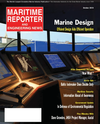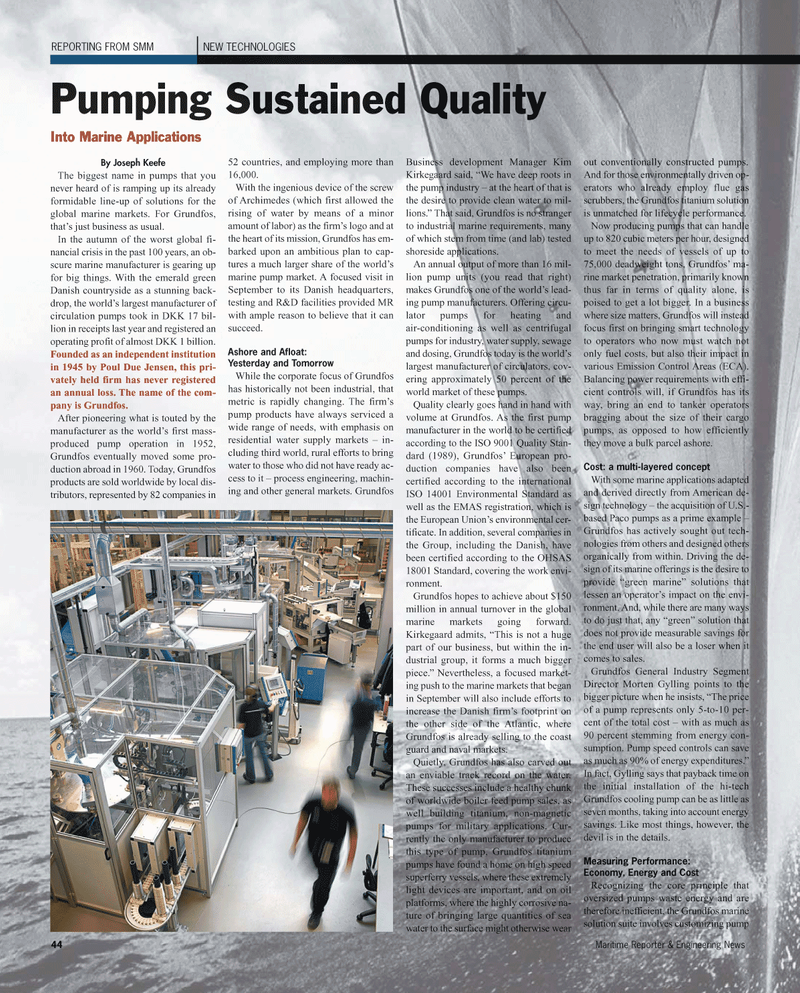
Page 44: of Maritime Reporter Magazine (October 2010)
Marine Design Annual
Read this page in Pdf, Flash or Html5 edition of October 2010 Maritime Reporter Magazine
By Joseph Keefe
The biggest name in pumps that you never heard of is ramping up its already formidable line-up of solutions for the global marine markets. For Grundfos, that’s just business as usual.
In the autumn of the worst global fi- nancial crisis in the past 100 years, an ob- scure marine manufacturer is gearing up for big things. With the emerald green
Danish countryside as a stunning back- drop, the world’s largest manufacturer of circulation pumps took in DKK 17 bil- lion in receipts last year and registered an operating profit of almost DKK 1 billion.
Founded as an independent institution in 1945 by Poul Due Jensen, this pri- vately held firm has never registered an annual loss. The name of the com- pany is Grundfos.
After pioneering what is touted by the manufacturer as the world’s first mass- produced pump operation in 1952,
Grundfos eventually moved some pro- duction abroad in 1960. Today, Grundfos products are sold worldwide by local dis- tributors, represented by 82 companies in 52 countries, and employing more than 16,000.
With the ingenious device of the screw of Archimedes (which first allowed the rising of water by means of a minor amount of labor) as the firm’s logo and at the heart of its mission, Grundfos has em- barked upon an ambitious plan to cap- tures a much larger share of the world’s marine pump market. A focused visit in
September to its Danish headquarters, testing and R&D facilities provided MR with ample reason to believe that it can succeed.
Ashore and Afloat:
Yesterday and Tomorrow
While the corporate focus of Grundfos has historically not been industrial, that metric is rapidly changing. The firm’s pump products have always serviced a wide range of needs, with emphasis on residential water supply markets – in- cluding third world, rural efforts to bring water to those who did not have ready ac- cess to it – process engineering, machin- ing and other general markets. Grundfos
Business development Manager Kim
Kirkegaard said, “We have deep roots in the pump industry – at the heart of that is the desire to provide clean water to mil- lions.” That said, Grundfos is no stranger to industrial marine requirements, many of which stem from time (and lab) tested shoreside applications.
An annual output of more than 16 mil- lion pump units (you read that right) makes Grundfos one of the world’s lead- ing pump manufacturers. Offering circu- lator pumps for heating and air-conditioning as well as centrifugal pumps for industry, water supply, sewage and dosing, Grundfos today is the world’s largest manufacturer of circulators, cov- ering approximately 50 percent of the world market of these pumps.
Quality clearly goes hand in hand with volume at Grundfos. As the first pump manufacturer in the world to be certified according to the ISO 9001 Quality Stan- dard (1989), Grundfos’ European pro- duction companies have also been certified according to the international
ISO 14001 Environmental Standard as well as the EMAS registration, which is the European Union’s environmental cer- tificate. In addition, several companies in the Group, including the Danish, have been certified according to the OHSAS 18001 Standard, covering the work envi- ronment.
Grundfos hopes to achieve about $150 million in annual turnover in the global marine markets going forward.
Kirkegaard admits, “This is not a huge part of our business, but within the in- dustrial group, it forms a much bigger piece.” Nevertheless, a focused market- ing push to the marine markets that began in September will also include efforts to increase the Danish firm’s footprint on the other side of the Atlantic, where
Grundfos is already selling to the coast guard and naval markets.
Quietly, Grundfos has also carved out an enviable track record on the water.
These successes include a healthy chunk of worldwide boiler feed pump sales, as well building titanium, non-magnetic pumps for military applications. Cur- rently the only manufacturer to produce this type of pump, Grundfos titanium pumps have found a home on high speed superferry vessels, where these extremely light devices are important, and on oil platforms, where the highly corrosive na- ture of bringing large quantities of sea water to the surface might otherwise wear out conventionally constructed pumps.
And for those environmentally driven op- erators who already employ flue gas scrubbers, the Grundfos titanium solution is unmatched for lifecycle performance.
Now producing pumps that can handle up to 820 cubic meters per hour, designed to meet the needs of vessels of up to 75,000 deadweight tons, Grundfos’ ma- rine market penetration, primarily known thus far in terms of quality alone, is poised to get a lot bigger. In a business where size matters, Grundfos will instead focus first on bringing smart technology to operators who now must watch not only fuel costs, but also their impact in various Emission Control Areas (ECA).
Balancing power requirements with effi- cient controls will, if Grundfos has its way, bring an end to tanker operators bragging about the size of their cargo pumps, as opposed to how efficiently they move a bulk parcel ashore.
Cost: a multi-layered concept
With some marine applications adapted and derived directly from American de- sign technology – the acquisition of U.S.- based Paco pumps as a prime example –
Grundfos has actively sought out tech- nologies from others and designed others organically from within. Driving the de- sign of its marine offerings is the desire to provide “green marine” solutions that lessen an operator’s impact on the envi- ronment. And, while there are many ways to do just that, any “green” solution that does not provide measurable savings for the end user will also be a loser when it comes to sales.
Grundfos General Industry Segment
Director Morten Gylling points to the bigger picture when he insists, “The price of a pump represents only 5-to-10 per- cent of the total cost – with as much as 90 percent stemming from energy con- sumption. Pump speed controls can save as much as 90% of energy expenditures.”
In fact, Gylling says that payback time on the initial installation of the hi-tech
Grundfos cooling pump can be as little as seven months, taking into account energy savings. Like most things, however, the devil is in the details.
Measuring Performance:
Economy, Energy and Cost
Recognizing the core principle that oversized pumps waste energy and are therefore inefficient, the Grundfos marine solution suite involves customizing pump
REPORTING FROM SMM NEW TECHNOLOGIES
Pumping Sustained Quality
Into Marine Applications 44 Maritime Reporter & Engineering News

 43
43

 45
45
